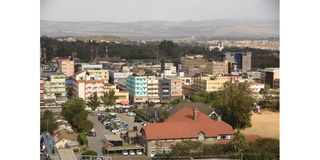How Nakuru rose to become Kenya's 'political capital'

A view of Nakuru city during the day
As Kenya celebrated 60 years of independence on June 1, Nakuru marked 71 years of existence.
You see, Nakuru was made a municipality in 1952 by the colonial government. Ever since, Nakuru has come a long way in terms of infrastructure, culture, diversity and many more.
From the first African mayor of Nakuru town the Late Geoffrey Kamau Macharia to the now Governor of Nakuru County Susan Kihika, Nakuru has seen a diverse array of leaders.
Over time, Nakuru has curved out a space for itself as the game changer when it comes to the political landscape of this Nation.
It is often said that when Nakuru decides the country has decided and even during the last campaigns, many noticed how the two main competitors Raila Odinga and William Ruto frequently visited Nakuru more than any other county, in a bid to try to sway the voters.
But how did this happen?
Taking a road down memory lane, Nakuru first rose to prominence during the Kenyatta era when Achieng’ Oneko, who was a Member of Parliament for the then Nakuru Town Constituency was chosen by the late President Jomo Kenyatta to be the minister of information, broadcasting and tourism.
He later resigned from KANU and the cabinet to join the late Jaramogi Odinga’s Kenya People Union party.
Nakuru was never accorded another minister until President Ruto’s administration, who appointed Zacharia Njeru as Cabinet Secretary for Lands.
Fast forward to the late President Daniel Arap Moi's regime.
It was during this time that Nakuru became monumental in politics.
Nakuru was an opposition stronghold and on the fore front of this was Koigi wa Mwere and Dickson Kihika. The two greatly opposed Moi and to be able to tame them, Moi brought in Kariuki Chotara to his side.
Kariuki was described by many as unapologetic and ruthless.
He was the right person to be able to effectively deal with the so called “Nakuru Mafia” and in deed he managed to do so.
Moi then rewarded him with a nomination to Parliament which translated to Nakuru becoming heavily invested in KANU by carrying out massive recruitments of members.
From that point on to this date, Nakuru has been an influential centre of Kenyan politics.
In 2013, Nakuru was the birth place of the famous Jubilee Alliance bringing together Uhuru Kenyatta and William Ruto at the historic Afraha stadium which led them to winning the election.
The duo also returned in 2016 to unveil the Jubilee Party and Nakuru voted for them overwhelmingly.
In the run up to the 2022 elections after numerous visits to Nakuru in the company of Mt. Kenya leaders, Raila Odinga launched his Azimio la Umoja Coalition in Nakuru.
His fierce competitor in the elections the current president William Ruto, Ford Kenya leader Moses Wetangula and ANC leader Moses Wetangula met at the Nakuru A.S.K grounds to solidify their union.
This contributed to the “yellow wave” that rocked Nakuru and the country at large.
Nakuru has an average population of about 2.1 million people and many regard it as the face of Kenya because of its diversity in ethnicity therefore being able to shape the opinion of the country.
With its ever growing population this political mileage will not be declining any time soon.
